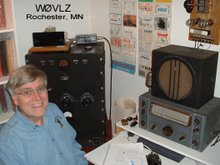As I played with my
6J5/6L6 transmitter I saw that I had some holes in my 80 mtr crystal selection. I had several crystals at 3550 but practically none between 3550 and 3570. Before stable and well calibrated VFOs were plentiful, grinding crystals was a common activity. Military surplus crystals were obtained cheap and ground to the frequency of interest. I decided to grind some of my 3550 KHz crystals up a few KHz to fill in the gaps in my crystal selection.
I used 400 grit wet sandpaper face up on a flat surface as my grinding "station". I removed the quartz crystal plate from the holder and, pressing on two diagonallyopposite corners, ground in a figure 8 pattern. I'd typically grind for 5 to 10 passes and then rotate 90 degrees, repeating four times. I then cleaned (with rubbing alchohol) and dried the crystal, reassembled it and checked the frequency. If I hadn't shifted it far enough I repeated the whole process. To insure that I ground only one side of the crystal I marked a side with a dot of ink.
I found that my Millen grid dip oscillator and a frequency counter made a handy crystal checker. I plugged the crystal in place of the GDO coil and capacitively coupled one pin to my frequency counter. The counter then read the crystal frequency and the grid current indicated crystal activity.
Additional tips:
- Try to limit the frequency shift. I've never gone beyond about 30 KHz.
- Use a large binder clip to temporarily hold the crystal holder
together when you test it. This saves screwing and unscrewing three
bolts every time you test for frequency.





















